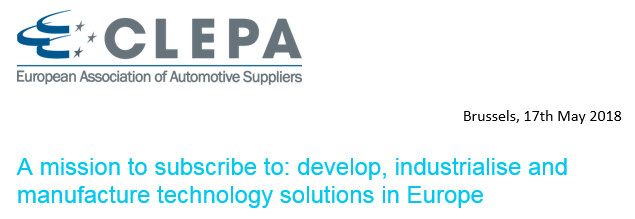
A mission to subscribe to: develop, industrialise and manufacture technology solutions in Europe
Date
Tue, 05/15/2018
Sections
Transport

In the third Mobility Package to be published today, the European Commission is expected to again, and rightly so, place a lot of emphasis on the importance of innovation and investment. Decarbonisation and digitalisation, the enablers for safer, smarter and sustainable mobility, cannot be achieved without R&D on our home turf, and already in the first and second Mobility Packages, the current Commission has paid testimony to the need to foster innovation.
The third Mobility Package is said to contain proposals on reducing CO2 emissions from commercial vehicles, on increasing the mandatory safety features in cars, on paving the way to automated driving, and on preparing the ground for next-generation battery manufacturing in Europe. All these proposals depend on innovative technology solutions, and the aim must be to develop, industrialise and manufacture these in Europe.
It’s encouraging therefore that also in the recent announcement on the EU Multiannual Financial Framework, the European Commission requested that a significant portion, €100 billion, is requested for the Horizon Europe, the new EU’s flagship Research Programme for 2021 and 2027 (€97.6 billion for the research programme and €2.4 billion for the Euratom nuclear research programme). That is an increase of almost 30% when adjusted for inflation on the EU’s existing Horizon 2020 research programme of €77 billion (without adjustment, the requested budget goes up to €86.6 billion).
To put it all into perspective: the overall 7-year budget spans €1 trillion, equivalent to 1.11 per cent of the EU27’s gross national income. But importantly, the new research programme is one of the few EU budget lines to go up in the Commission’s seven-year proposal. Another is the Erasmus+ student exchange programme, which sees its budget double to €30 billion. The Commission also requested €4.1 billion funding for defence research, a big increase from the current €90 million pilot programme.
It’s an early, yet certainly not final, victory for R&D, even if the proposal falls short from the €120 billion asked for by the European Parliament, and the €160 billion recommended in the “Lamy report”. Like all EU decisions, the proposal will require many rounds of scrutiny before final adoption. The proposal will need unanimous agreement from the EU’s member countries and consent from the Parliament, a process expected to last more than a year.
There is a lot at stake: R&D and innovation underpin the competitiveness of industry in the global environment, and Europe is still behind when it comes to dedicating resources in this field. CLEPA, like others in industry, will closely accompany these important discussions and provide tangible input where needed. Automotive suppliers are among the biggest private investors in R&D.
The other pillar sustaining Europe’s global competitiveness is a supportive legislative framework, providing a predictable framework for industry to invest and plan ahead. That is why CLEPA supports and promotes the setting of long-term targets that are ambitious as well as realistic – for example for reducing CO2 emissions from passenger cars and trucks. And it is why CLEPA advocates the timely revision of key pieces of regulation as well, such as the General Safety Regulation (GSR). The latter is in fact long overdue, hindering advances that could be made in meeting the EU road safety targets. CLEPA urges that the GSR revision, par of the third Mobility Package, is brought through the institutions before the legislature closes in 2019, to avoid that further delays occur.
Sigrid de Vries
Secretary General
